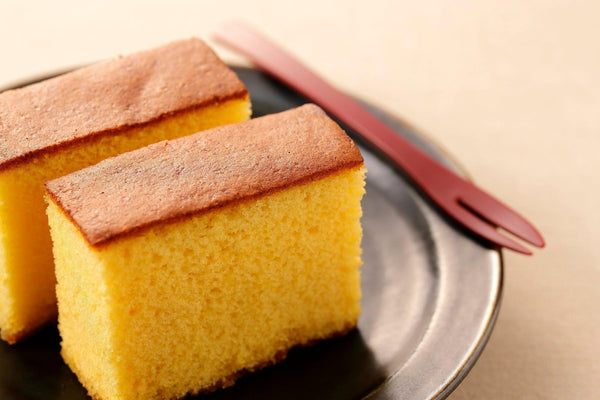
Jump to:
Japanese desserts are a fan favorite for many folks with a sweet tooth, and deservedly so.
Among the many iconic Japanese sweets is Castella, a fluffy sponge cake that occupies a prominent position in the halls of Japanese traditional sweets, a category known as 'wagashi.’
Castella incorporates its Spanish heritage while bearing the hallmarks of Japanese attention to detail as well as a markedly delicate and balanced flavor profile.
Today we’ll whisk you through the captivating journey of Castella, from its Spanish origins and Japanese evolution to regional variations as well as the best places to buy this sweet delicacy in Japan and beyond.
What Is Castella? What Does It Taste Like?
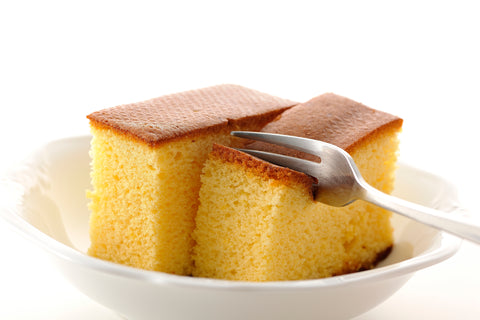
The Japanese Castella cake (a.k.a. “kasutera” – the romanization of the Japanification of a Spanish-Portuguese word – or カステラ) is made of seemingly simple ingredients: sugar, flour, eggs, and sometimes honey or syrup for extra sweetness and moistness. Mirin is another ingredient found in many versions of this popular Japanese dessert.
Castella typically has a soft, light, and bouncy texture that's unlike other traditional cakes. Castella is adored for its subtle sweetness (typical for wagashi and other Japanese desserts) and for its moist, fine-grained texture.
The taste profile of Castella is a carefully struck balance of sweet and savory, making it an ideal accompaniment to tea (especially Japanese green tea, of course). Indeed, Castella is a traditional favorite during tea time in Japan.
Its mild sweetness is derived mainly from sugar and honey in the recipe, while the savory hints are an outcome of the eggs. It is this precise balance that makes Castella distinct from other types of sponge cakes. Whether enjoyed on its own or accompanied by a warm cup of tea, Castella, with its unique (and distinctively Japanese) flavor palette, is a Japanese dessert indulgence that you’ll likely want to experience again and again. Want to try making castella at home? Check out our recipe to learn how to!
How Is Castella Enjoyed In Japan?
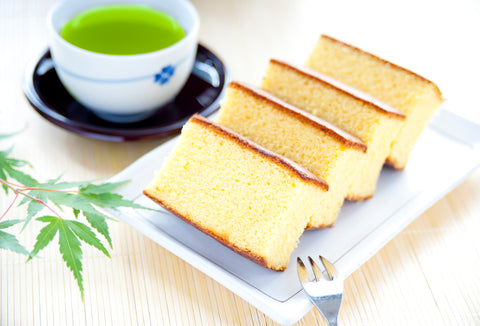
The experience of eating Japanese Castella cake transcends a simple snack to embrace purpose and intentionality.
Castella is often eaten during tea time, plated in simplicity alongside a steaming pot of green tea. Its delicate sweetness complements the slightly bitter, aromatic tea, providing an ideal balance for dessert, snack, or afternoon tea.
During celebrations or festival days, beautifully boxed Castella is also a popular gift choice, a symbol of auspicious and sweet beginnings. It can be found at specialty bakeries and confectionery shops across Japan, as well as in department store food halls (a.k.a. “depachika”).
Nagasaki (where the cake was first introduced in Japan) has a tradition of eating Castella during the Obon holiday, an annual time for commemorating family ancestors. The cake is considered a delicacy and is often served to guests during special occasions and celebrations.
It’s not uncommon to see “Nagasaki” in the name, signage, and/or packaging of Castella cake shops and brands. Mentioning the historic port city brings an image of Castella's tradition and excellence to the minds of many Japanese people.
Castella’s Texture, And The Ingredients That Make It So
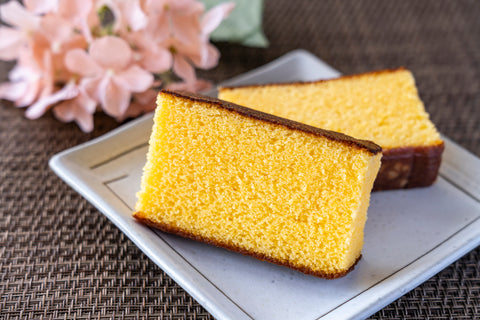
Japanese Castella cake is revered for its exceptional texture, something you’ll likely notice right away upon the first bite.
With a fine, tightly knit crumb, Castella is delightfully moist and lusciously smooth; it’s often described as “bouncy” or “springy.” This harmony between being densely rich and light at the same time is an attribute that sets Japanese Castella cake apart from other sponge cakes.
The ingredient list for Castella would appear to be simple enough — flour, eggs, and sugar, at the core (with honey and/or mirin beyond that. And yet the execution serves as a reminder of the adage “the devil is in the details.”
Some versions add honey or syrup, lending additional moistness and a subtle floral sweetness to the cake. In certain variations, mizuame, a Japanese starch syrup, is used to enhance the texture and taste; more often, mirin is seen in Castella. All such versions of Castella are mainstays in the lineup of wagashi confectionery.
Japanese Castella cake lacks a rising agent, setting it apart from typical cakes. The lofty rise and spongy texture solely rest (pun intended) on the air incorporated into the eggs when beaten. This requires a certain timing and focus, a true commitment to process and methodology, emphasizing the importance of technique in creating this delicate Japanese dessert.
Indeed, Castella is a testament to Japan's culinary philosophy: a focus on core flavors, refined techniques, and the transformative power of simplicity in creating remarkable culinary experiences.
Where Does Castella Come From? How Did It Become A Japanese Cake?

Ironically, Castella, one of the most cherished Japanese desserts, owes its origins to a foreign land – the Kingdom of Castilla, in Spain. Its journey from Europe to East Asia reflects the course of history and embodies Japan’s affinity for adaptation and evolution (both in cuisine and in the broader culture).
Introduced by Portuguese missionaries in the mid-16th century, Japanese Castella cake was initially a confectionery enjoyed by the nobles of the era. The name 'Castella' is believed to have been derived from the term 'Pão de Castela', meaning 'bread from Castile.’ The aforementioned Kyushu port city of Nagasaki, a critical location for foreign trade and exchange at that time, became the birthplace of Castella in Japan.
Despite its foreign origin, Castella evolved to suit the refined Japanese palate. Over time, Japanese bakers modified the recipe, adding new ingredients such as mizuame or mirin to enhance the taste and texture. The essence of Castella's history lies in its transformation – a European import morphing into an integral part of Japan's wagashi culture.
Japanese Castella vs Original Castella
Though hailing from the same roots, the Japanese Castella cake and its original Spanish predecessor have undergone a significant divergence in their culinary journey.
Both versions of Castella possess the qualities of a sponge cake; their textures, tastes, and even cultural significance, however, set them apart.
The Japanese dessert of this name stands out for its fine texture, moist consistency and subtly sweet flavor, nodding to the preference for delicate, less sugary confectionery that form the wagashi category. The original Castella from Spain, on the other hand, features a coarser crumb with a heartier wheat flavor.
Additionally, the cultural context of these cakes varies widely. In Japan, Castella is deeply embedded in native customs and rituals, considered a symbol of prosperity and a popular gift item during celebrations. In Spain and other parts of Europe, meanwhile, Castella is one of many sponge cakes, lacking the cultural reverence it enjoys in Japan.
Beyond the Original Japanese Castella Cake: Several Varieties
The Castella found in Japan today exists in a multitude of varieties, each lending its unique spin to the classic recipe. Below are some popular variants.
Honey Castella
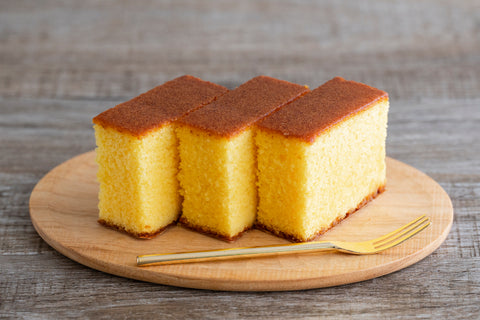
Probably the most common variety of Japanese Castella cake, honey Castella infuses the cake batter with honey. This imparts a deeper sweetness and distinct aroma, creating a beautifully amber-colored sponge cake.
Brown Sugar Castella

In this variant, refined white sugar is substituted with brown sugar. This gives the Castella a darker color and a rich, molasses-like flavor, adding a more complex sweetness to the finished cake.
Matcha Castella
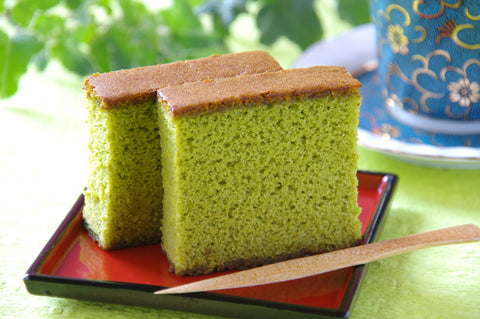
Incorporating traditional Japanese flavors, Matcha Castella contains the famous Japanese green tea powder, providing a distinctively green hue and a subtly bitter taste that balances with the cake's sweetness.
Cheese Castella
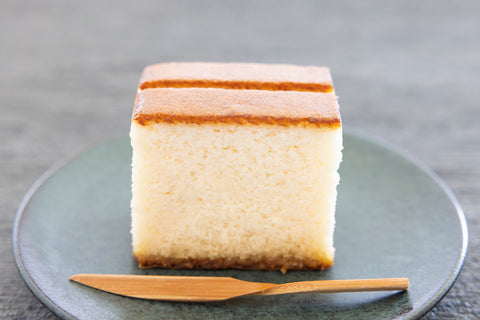
This version of Japanese castella cake includes a subtle addition of cheese, resulting in a creamy, rich flavor profile that harmoniously melds with the sweet tones of the traditional version. Cheesecake aficionados are unlikely to be disappointed with this Japanese dessert.
Baby Castella

If you’ve been to a festival or fair in Japan, you’ve likely seen, smelled and/or eaten baby Castella. These popular one-bite snacks are somewhat akin to doughnut holes in size, with a move oval shape and a more pillowy inside. They are served hot and handed to the customer in a paper bag of 10-15 pieces of baby Castella, much like one would have mini-donuts at a fair in the US or elsewhere.
Japanese Castella vs Other Castella (Taiwan & Asia)
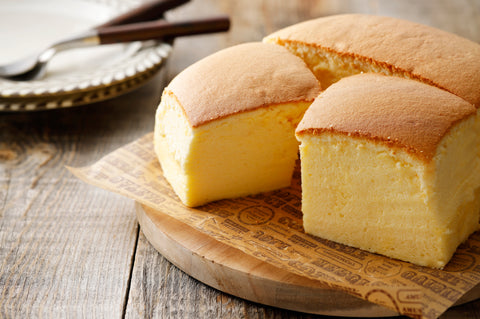
While Japanese Castella has become intrinsically associated with Japan's culinary identity, it's worth noting that variants of this delicious confectionery have also found their way into other Asian cuisines, most notably Taiwanese.
Taiwan’s Castella differs from its Japanese counterpart primarily in size and texture. Often much larger, Taiwanese Castella cakes are known for their rather jiggly texture, resulting from a higher proportion of eggs used in the batter. Taiwanese Castella is more like a souffle, versus the denser and moist Japanese dessert version.
Culinary explorers might argue as to which variant is superior, but we can all agree that each brings a slice of its respective culture.
Best Castella Shops To Visit In Japan
Savoring Castella in Japan is not just about the taste, but also the experience. Numerous bakeries specializing in Castella have been proudly selling their beloved Japanese dessert for decades or even centuries. Here are some must-visit shops:
Fukusaya
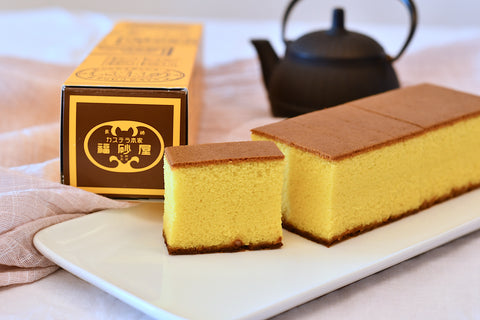
Established in 1624 and operating in Nagasaki, Fukusaya is the oldest Castella bakery in Japan. Known for their strict adherence to traditional methods, the Castella from Fukusaya is consistently top-notch, offering a rich taste of history with each bite.
Bunmeido
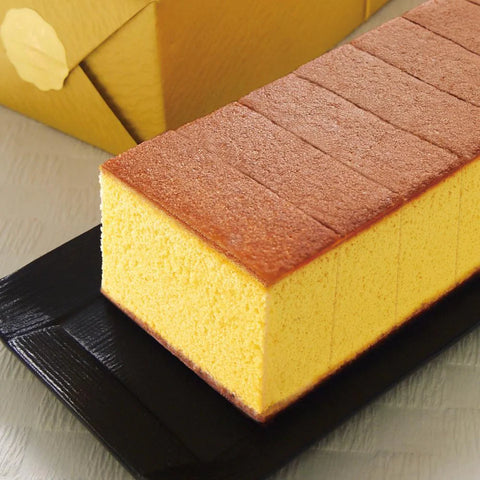
Founded in Nagasaki in 1900, Bunmeido has shops all over Japan. They are known for their traditional baking methods over charcoal, resulting in a distinct flavorful cake with a beautiful, even brown top.
Shooken
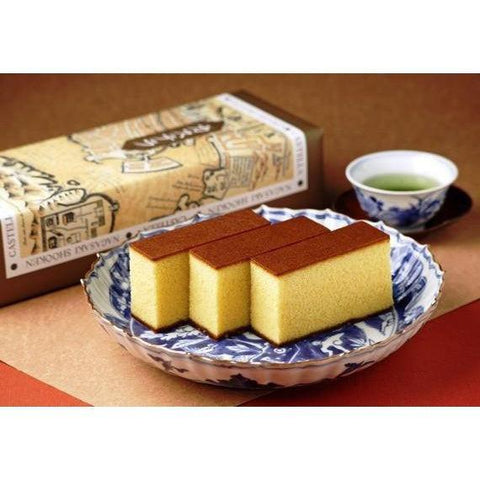
Another historical establishment based in Nagasaki, Shooken offers a signature Castella made without molds, imparting a uniquely personal touch to their cakes.
These bakeries have guarded their Castella recipes over generations, replicating traditional tastes while ensuring consistent high quality – making the experience of trying their Castella an essential part in any exploration of Japanese desserts.
Where To Buy Castella In Japan And Beyond
Finding a piece of decent quality Castella in Japan is an easy feat given its popularity. Major supermarkets and convenience stores commonly store pre-packaged Castella, often offering a range of flavors like honey, matcha, and brown sugar. You can’t go wrong here, of course.
For artisanal varieties, however, visiting specialized Castella shops like Fukusaya, Bunmeido, and Shooken is highly recommended. These establishments have perfected the art of Castella baking over centuries.
Not in Japan? We’ve got Castella right here at Japanese Taste! Earlier we mentioned these two traditional favorites, each of which are available on our website:
- Bunmmeido
- Shooken Nagasaki (3 flavors!)
We also carry a long shelf-life (additive-free) Castella made by Kashuen Moricho, another fan favorite, in both honey and matcha varieties.
Japanese Castella Cake: Experience The History & Flavor

From a thorough exploration of its history to textures, tastes, and types, it's easy to see why Japanese Castella cake has etched itself into the fabric of wagashi culture.
More than merely a sponge cake, Castella encapsulates a journey and an experience. Whether you're indulging in a slice in a historical shop in Nagasaki or serving it at home, each slice of this Japanese dessert represents a piece of culinary history and culture.


0 comments